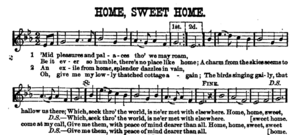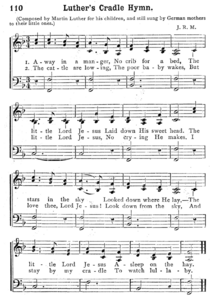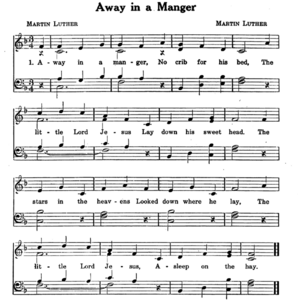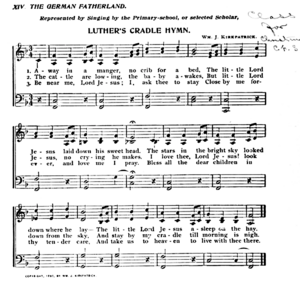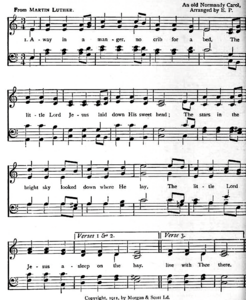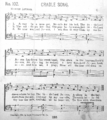Away in a Manger facts for kids
Quick facts for kids Away in a Manger |
|
|---|---|
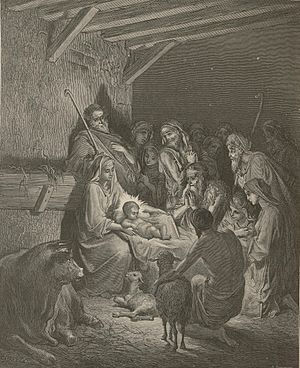
"The Birth of Jesus" (1878) by Gustave Doré
|
|
| Genre | Christmas carol |
| Written | 1882 |
| Based on | Luke 2:4-7 |
| Meter | 11.11.11.11 |
| Melody | "Cradle Song" by William J. Kirkpatrick, "Mueller" by James R. Murray |
"Away in a Manger" is a very popular Christmas carol that was first published in the late 1800s. People all over the English-speaking world sing it. In Britain, it's one of the most loved carols. A survey in 1996 even showed it was the second most popular!
For a long time, many people thought the famous German religious leader Martin Luther wrote this carol. But today, experts believe it actually started in America. The two most common tunes for "Away in a Manger" were created by William J. Kirkpatrick in 1895 and James Ramsey Murray in 1887.
Contents
The Words of the Carol
The words of "Away in a Manger" are well-known, but they have changed a little over time. Here are the words from William J. Kirkpatrick's version from 1895:
Away in a manger, no crib for a bed,
The little Lord Jesus laid down his sweet head.
The stars in the bright sky looked down where he lay,
The little Lord Jesus asleep on the hay.
The cattle are lowing, the baby awakes,
But little Lord Jesus, no crying he makes.
I love thee, Lord Jesus! look down from the sky,
And stay by my cradle till morning is nigh.
Be near me, Lord Jesus; I ask thee to stay
Close by me forever, and love me I pray.
Bless all the dear children in thy tender care,
And take us to heaven to live with thee there.
How the Words Changed
Over the years, many small changes have appeared in the carol's words. For example:
- The first line sometimes said "no crib for his bed" instead of "no crib for a bed."
- The second line sometimes used "lay down" instead of "laid down."
- The third line of the first verse was often shorter. Later versions added words like "bright" or "heaven" to make it fit the music better.
- The last line of the second verse has many different versions. One popular change is "And stay by my cradle till morning is nigh."
- The third verse wasn't in the very first versions of the carol. It was added later, around 1892.
Why the Carol is So Popular
"Away in a Manger" quickly became very popular. By 1883, it was already being sung in Sunday Schools in places like Nashville, Tennessee. It even reached far-off places like India by 1884, where people loved to sing it. By 1891, the carol was "sweeping the country" (the United States), showing how quickly it spread and became a favorite.
A Line That Made People Think
In the second verse, the line "But little Lord Jesus, no crying he makes" has made some people wonder. Some thought it meant Jesus wasn't fully human because babies usually cry. However, the carol describes Jesus waking up quietly when the cattle make noise. Just like some babies wake up and stay calm, this line simply shows Jesus as a peaceful baby, which doesn't mean he wasn't fully human.
The Music of the Carol
"Away in a Manger" is sung to several different tunes. The two most famous ones are "Mueller" and "Cradle Song."
"Mueller" Tune
<score %vorbis="1"%> \new Staff << \autoBeamOff \time 3/4 \key f \major \partial 4 \relative c { c4 | c4. bes8 a4 | a4. g8 f4 | f4 e4 d4 | c2 c4 | \break c4. d8 c4 | c4 g'4 e4 | d4 c4 f4 | a2 c4 | \break c4. bes8 a4 | a4. (g8) f4 | f4 e4 d4 | c2 c4 | \break bes'4. a8 g4 | a4 g4 f4 | g4 d4 e4 | f2 | \bar "|." } \addlyrics { A -- way in a man -- ger, No crib for a bed, The lit -- tle Lord Je -- sus Laid down His sweet head. The stars in the sky Looked down where He lay, The lit -- tle Lord Je -- sus A -- sleep on the hay. } >> \layout { indent = #0 } \midi { \tempo 4 = 106 } </score> The "Mueller" tune is the most popular one in the United States. James R. Murray first published this melody in 1887 in his songbook Dainty Songs for Little Lads and Lasses.
When Murray published it, he said the hymn was "composed by Martin Luther for his children." But he only put his own initials as the composer. Because of this, other music publishers thought he had only arranged the music, not written the tune itself. So, Murray's melody started appearing in other songbooks without his name on it. By 1914, the tune was often credited to someone named "Carl Mueller," even though no one knows who Carl Mueller was. That's why this tune is still known as "Mueller" today.
"Cradle Song" Tune
<score %vorbis="1"%> \new Staff <<
\autoBeamOff \time 3/4 \key f \major \partial 4 \relative c'{ c4 | f4 f4 g8 ([a8]) | f4 f4 a8 ([bes8]) | c4 c4 d4 | bes2 g8 ([a8]) |
\break
bes4 bes4 c4 | a4 a4 f8 ([a8]) g4 d4 f4 | e2 c4 |
\break
f4 f4 g8 ([a8]) | f4 f4 a8 ([bes8]) | c4 c4 d4 | bes2 g8 ([a8]) |
\break
bes4 bes4 c4 | a4 a4 f8 ([a8]) g4 d4 e4 | f2 | \bar "|." }
\addlyrics { A -- way in a man -- ger, no crib for a bed, The lit -- tle Lord Je -- sus laid down his sweet head. The stars in the bright sky looked down where he lay, The lit -- tle Lord Je -- sus a -- sleep on the hay.} >> \layout { indent = #0 } \midi { \tempo 4 = 106 } </score> The "Cradle Song" tune is the most common melody for "Away in a Manger" in Britain and Ireland. This tune was written by the American composer William J. Kirkpatrick. It was first published in 1895 in a collection called Around the World with Christmas. In that book, "Away in a Manger" was presented as a song from "The German Fatherland," still linking it to the Martin Luther story.
Kirkpatrick's melody became very popular and helped the carol spread beyond the United States. It's still the most popular tune for "Away in a Manger" outside of America.
Other Musical Versions
Many different musical versions of "Away in a Manger" exist. One expert found nearly 200 different tunes for the carol!
- One of the very first ideas for a tune was the song Home! Sweet Home! (also known as "There's No Place Like Home").
- The first known tune written specifically for "Away in a Manger" was called "St. Kilda." It appeared in a book for Sunday Schools in 1885.
- Another popular tune was created by John Bunyan Herbert in 1891.
- Charles H. Gabriel, who added the third verse, also created many different musical arrangements for the carol.
- Some versions use the melody of "Flow Gently, Sweet Afton" by Jonathan E. Spilman.
- There's even an arrangement from 1911 that uses an "old Normandy Carol" tune.
- A special arrangement combines the two most popular tunes, Kirkpatrick's and Murray's. In this version, different choirs sing each tune, and then they sing them together for the last verse.
- Musical settings of "Away In A Manger"
See Also
- Away in a Manger lyrics at Wikisource.org
Images for kids


